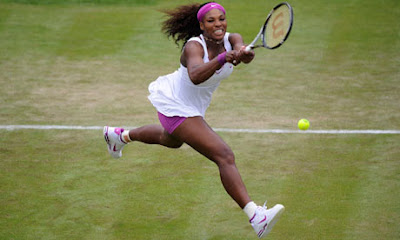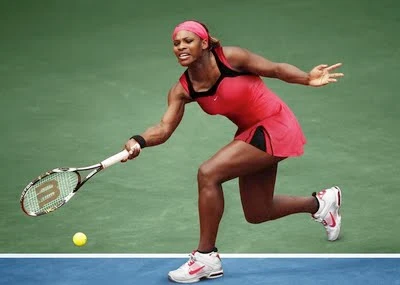Serena Williams: “Ain’t I a Champion?”
by David J. Leonard | NewBlackMan (in Exile)
On Saturday, Serena Williams captured her 5th Wimbledon title (later in the day, she and Venus would secure a double’s title as well). Since 1999, the Williams sisters have captured 10 titles at the all-England club. Yet, for each of them, this success has not come without trials and tribulations. Over the last few years, Serena has suffered countless injures, including a blood clot in her lungs. Battling insomnia, depression, physical ailments, and the tragedy of her sister’s murder, Serena has overcome obstacles far more challenging than a Sharapova backhand. “I definitely have not been happy,” Williams announced in 2011. “Especially when I had that second surgery (on my foot), I was definitely depressed. I cried all the time. I was miserable to be around.” In other words, Serena Williams has secured greatness on and off the court, thriving in spite of tremendous hardship.
Within a culture that thrives on stories of redemption, that celebrates resilience and determination, the career of Serena Williams reads like a Hollywood screenplay. Yet, her career has been one marred by the politics of hate, the politics of racism and sexism. Last year I wrote about the treatment she has faced from fans and media alike:
What is striking about the comments and several of the commentaries as well, is the demonization of Serena Williams. Focusing on her body (reinforced by the many pictures that sexualize Williams), her attitude, and her shortcomings as a player, the responses pathologize Williams. “The Williams sisters have been criticized for lacking ‘commitment’ by refusing to conform to the Spartan training regime of professional tennis, restricting their playing schedules, having too many ‘off-court interests’ in acting, music, product endorsements, fashion and interior design, and their Jehovah’s Witness religion” (McKay and Johnson).…
“The Williams sisters also have been subjected to the carping critical gaze that both structures and is a key discursive theme of ‘pornographic eroticism’,” writes James McKay and Helen Johnson. Similarly, Delia Douglas argues, a “particular version of blackness” is advanced within the representations of the Williams sisters. We see the “essentialist logic of racial difference, which has long sought to mark the black body as inherently different from other bodies. Characterizations of their style of play rely on ‘a very ancient grammar’ of black physicality to explain their athletic success”
This monumental victory also didn’t lead to a celebration, a coronation of the greatest player of her generation (and maybe in history), but instead more of the same. The story of redemption and the beauty of her game isn’t the story found throughout the cyber world, from twitter to the comment section of various sports websites.
Her victory prompted tweets referring to her by the “N Word” and several more about her body and sexuality. Reflecting an atmosphere of racist and sexist violence, of dehumanizing rhetoric, tweets referring to her as a gorilla flowed throughout cyberspace with great frequency (some of the below appeared over the last week).
- · Today a giant gorilla escaped the zoo and won the womens title at Wimbledon… oh that was Serena Williams? My mistake.
- · Serena Williams is a gorilla
- · Watching tennis and listening to dad talk about how Serena Williams looks like gorilla from the mist
- · I don’t see how in the hell men find Serena Williams attractive?! She looks like a male gorilla in a dress, just saying!
- · You might as well just bang a gorilla if you’re going to bang Serena Williams
- · Earlier this week I said that all female tennis players were good looking. I was clearly mistaken: The Gorilla aka Serena Williams.
- · serena williams looks like a gorilla
- · Serena Williams is half man, half gorilla! I’m sure of it.
- · Serena Williams look like a man with tits, its only when she wears weave she looks female tbh, what a HENCH BOLD GORILLA!
- · Serena Williams is a gorilla in a skirt playing tennis
#Wimbledon - · My god Serena Williams is ugly! She’s built like a silver backed gorilla
- · I would hate to come across Serena Williams in a dark alley
#nightmare#gorilla#notracist - · Serena williams is one of the ugliest human beings i’ve ever seen
#Gorilla - YouTube posts offered similar responses to her victory:
- · A man? look at her body, more like a silver back gorilla. I can easily imagine her charging through the jungle breaking trees while flexing those muscles. Doesn’t help that her nose looks like a gorillas as well. I keep expecting to see her zoo handlers to chain her up after the match before she can escape.
- · Monkey business
- · i ddnt know apes wer allowed in women tennis O_O
It would be a mistake to dismiss these comments as the work of trolls or extremists whose racism and sexism put them outside the mainstream. Just as the Obamas, just as Dr. Christian Head, just as Mario Balotelli was depicted as King Kong in a recent cartoon, and just as just as soccer andhockey players from throughout the Diaspora face banana peels and monkey chants, the racism raining down on Serena’s victory parade highlights the nature of white supremacy. It embodies the ways that white supremacy demonizes and imagines blackness as subhuman, as savagery.
Continue reading @ NewBlackMan (in Exile): Serena Williams: “Ain’t I a Champion?”.



